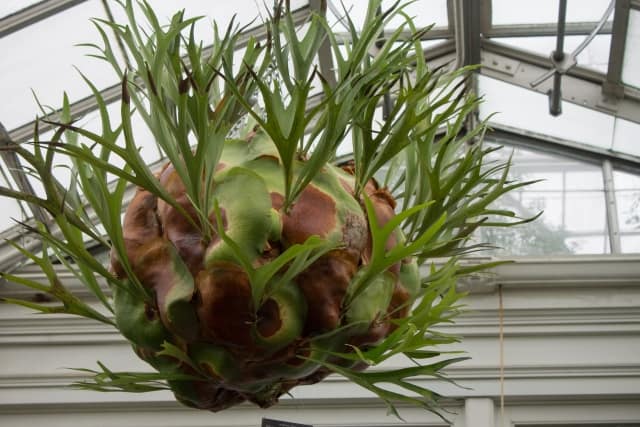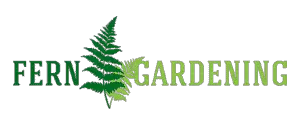One of the most curious – and certainly curious-looking – of the ferns is the staghorn fern. This unusual specimen has a weird, alien appearance that is far removed from the classic feathery shape of a typical woodland fern.
Staghorn ferns (Platycerium bifurcatum) are “epiphytic” plants that grow naturally high up in the canopies of trees, anchored to the bark, but without causing any damage or harm to the tree itself. The unusual appearance of the staghorn fern comes from its two types of frond – gray-green, bifurcated fronds that look like antlers and give the plant its name, and flattened, brown shield fronds that help anchor the fern to the tree and trap nutrients and water.
Many species of staghorn ferns are grown, and they make arresting and eye-catching decorations in the house or garden.

Staghorn fern
- Platycerium bifurcatum
- Evergreen
- Prefers partial shade
- Height: up to 1 m
- Epiphytic (but can be grown on loam). Keep moist, well-drained.
Where do staghorn ferns come from?
Staghorn ferns are found naturally in the rainforests of Australia, New Guinea and Indonesia. They cling to the trunks of trees, growing in this epiphatic mode rather than directly in soil. Their roots are mainly used to anchor the plant to the surface of the bark, with most nutrient and water absorption happening in the fronds. It is a remarkable and striking life cycle, and a precarious ecological niche. Despite this balancing trick, Staghorns can thrive in this unique position, forming thickets of ferns around the tree, reaching for the filtered light that penetrates through the canopy above.

This association does not hurt the tree. The staghorn does not steal nutrients or damage the tree like parasitic plants such as mistletoe, instead sustaining itself from whatever dead leaves and rotting bark can be trapped as it falls from above, or is washed down in rainwater.
Because of this tropical origin, staghorn ferns grown for domestic appreciation are best suited to hotter climates or indoor locations where there is little danger of frost or cold damage. If mounted or hanging, the plant can be moved outside in summer months.
What kinds of staghorn ferns are there?
Staghorn ferns are known by several other names, including elkhorn ferns, Australian elk’s horn ferns, and antelope ears. There are several Platycerium species available for sale, and also some crosses and cultivars to add even more diversity. This video from Herb Halling of the Los Angeles County Arboretum gives a comprehensive overview of all the options available:
Despite that diversity and range, the commonest variety stocked by nurseries and garden centers is Platycerium bifurcatum, and the principles for how to grow and mount this common staghorn fern apply generally to most of the species.
How to grow and mount staghorn ferns
The secret to successful cultivation and care of staghorn ferns is to mimic natural conditions as far as possible. In the wild, staghorn ferns grow in the canopy of rainforests, capturing whatever water and nutrients they can from the dead leaves and detritus carried down the rain-washed trunk of the tree. That means they are used to surviving on meager rations, making them robust and low-maintenance houseplants.
Juvenile staghorn ferns are grown in pots, with a loam soil mix being ideal. As the fern grows, the sterile shield fronds will develop at the base of the plant as a round or heart-shaped plate. If the fern experiences a period of drought the shield frond can turn brown, but this is a natural and expected development, and no cause for alarm. The fertile “bifurcated” or forked fronds grow upwards and away from the shield fronds, and have the characteristic antler-like appearance that give the plant its name. These fronds are green, but often have a grayish tinge, caused by fine white hazy hairs that cover the surface. This coating helps the fronds retain moisture, and should not be mistaken for mold or mildew.

Once the staghorn is big enough, it is best transferred to a mount. The plant can be removed from the pot, and the roots eased apart and splayed outwards onto a wooden board (or log, if a more naturalistic look is wanted). The bifurcated fronds will continue to grow upwards from the rhizome, so the fern should be positioned with the rhizome (from which new fronds would be emerging) at the top when the mount is raised vertically – typically this results in the shield fronds being positioned at the bottom of the plant. It is best to plan ahead and secure the eyelets and nails needed for hanging the mount before you transplant the fern.
The soil can be packed round with moss – sphagnum is best, if available – to provide moisture, protection and trap nutrients. This aggregate must then be secured against the mount with netting or nylon line to secure enough of the soil, root and sphagnum package to allow the fern time to form a natural anchor. Twine can be used, but this is vulnerable to fraying and breaking (particularly after watering), which may cause the fern to fall from the mount. Alternatively, the root ball can be tucked into a small, porous pouch (such as coir matting, as used in hanging baskets), which is then hung and attached to the wooden surface.
Staghorns need additional minimal soil or fertilizer once established. If you are concerned that the fern is failing to thrive, a low dose of balanced fertilizer can be used occasionally to help it along. In time, the fern can also grow to overwhelm the original mount, at which point it can be transferred to a larger mount with a fresh dose of leaf mold based compost – a sort of “repotting” onto a larger fake tree!
Watering of the mounted fern should also mimic the conditions expected in nature. Rain is unpredictable, but rainforests are naturally humid. This is the ideal scenario for your ferns too, and can be reproduced by allowing for cycles of dry and wet conditions. The fern should be mounted away from drafts to help protect against dehydration, and occasional misting is recommended to maintain humidity. Some enthusiasts will mount their Staghorn in the bathroom, either permanently if light levels are sufficient, or for occasional humidifying visits to rejuvenate the plant.
The ferns should be allowed to occasionally become dry for short periods before watering, as this helps to harden and mature the shield fronds as would occur in the wild. To water the mounted fern, it is best to craft a “nest” like pocket at the top of the mossy root ball, into which water can be dripped (again, reproducing the way the ferns would receive water in the rainforest). An alternative to this method is to submerge the entire mounted plant into a bucket or bath of water, and allow the moss, wood and fern to soak up a healthy reserve of water.
A final consideration is the position of the mount relative to light. Although staghorns prefer partial shade, the bifurcated fronds will grow towards the sun. This is how they are adapted to their natural climate, up in the canopy of the rainforest and searching for sunlight. Accordingly, it is best to position the ferns facing towards the light source (though not in direct sun). If the fern is positioned facing to the side or away from the light, the fronds may grow to be lopsided and asymmetrical.
Staghorn ferns are amazing, spectacular plants. They are easy to maintain, rewarding to grow, and a striking addition to any garden, greenhouse or room.
